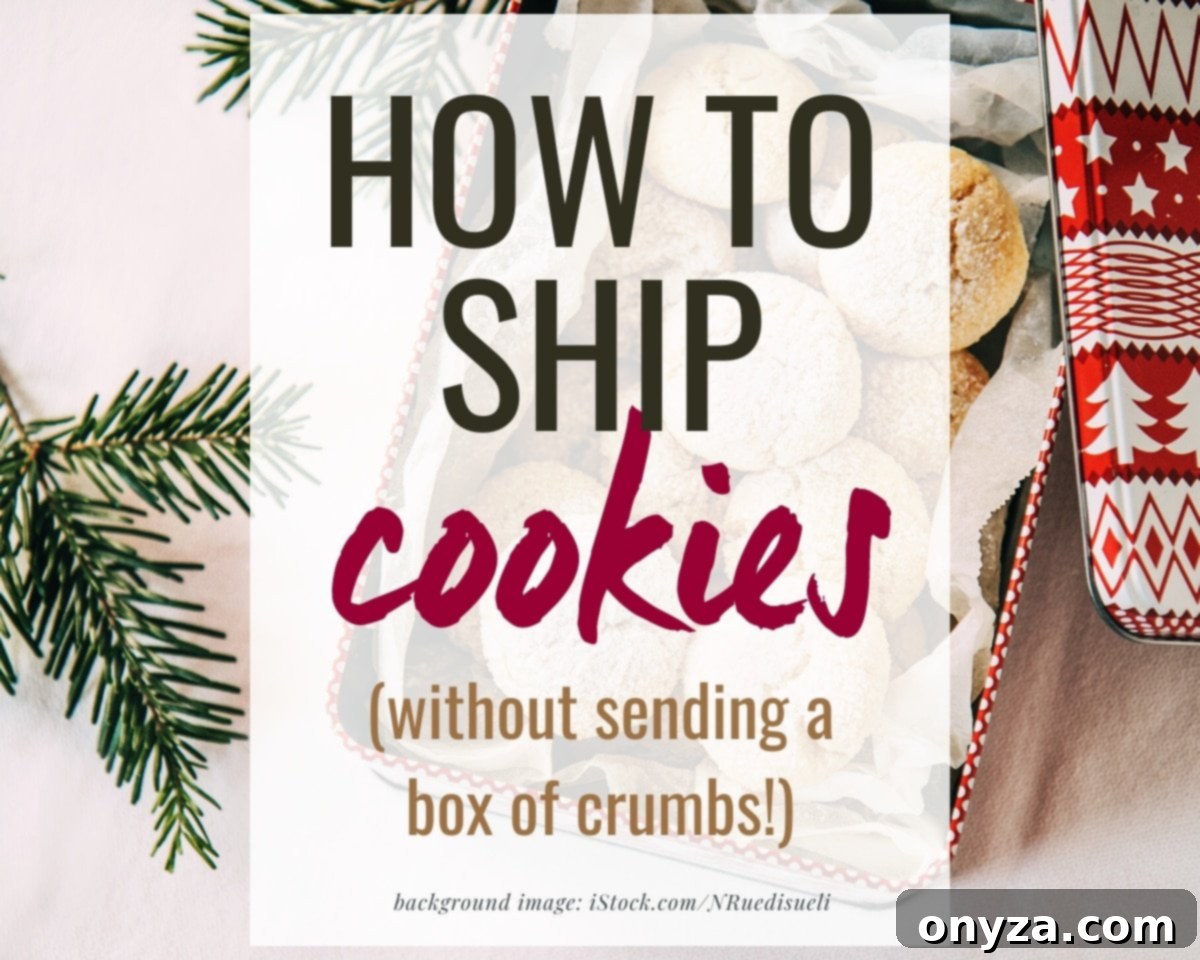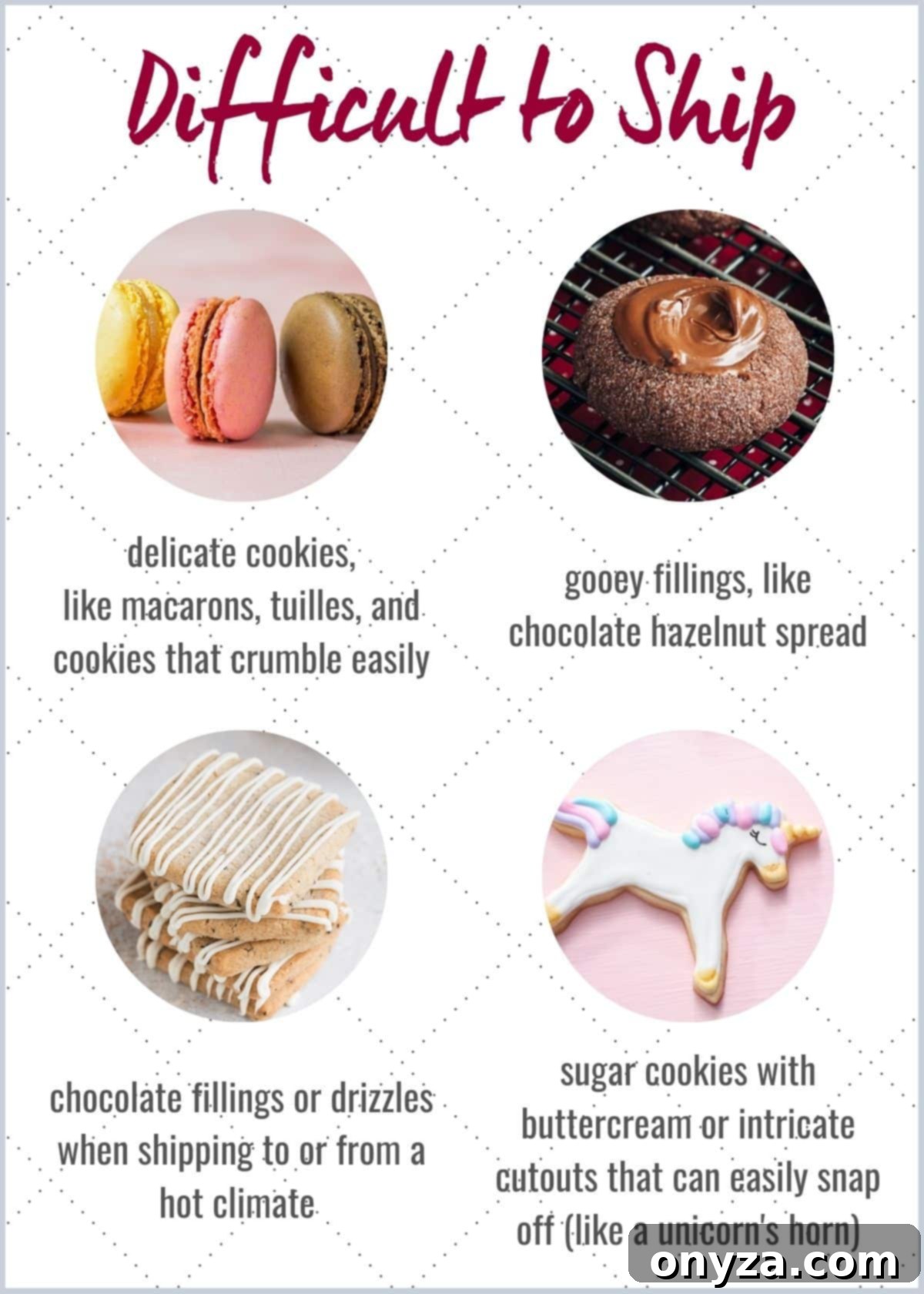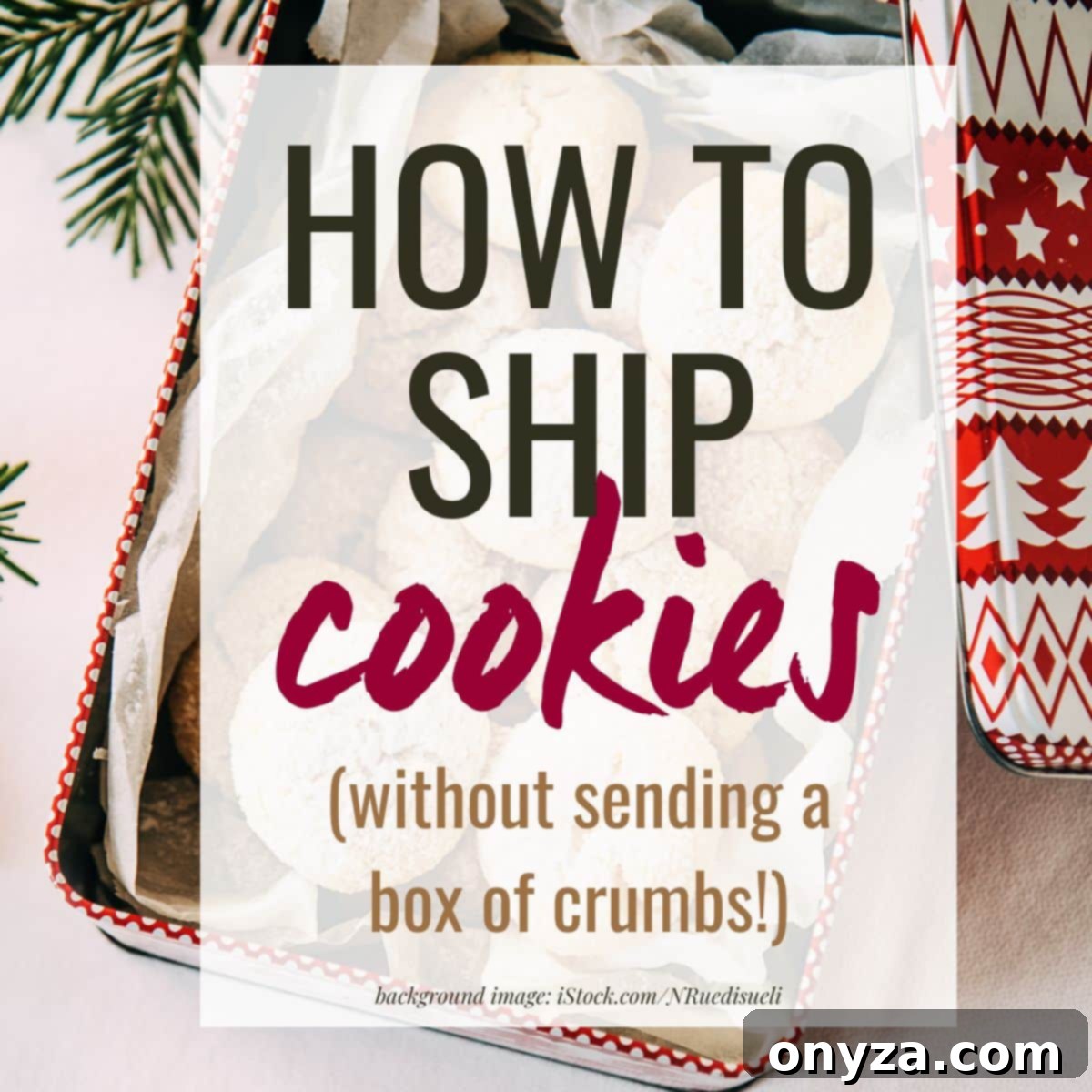Sending a homemade treat across the miles? Our comprehensive guide on how to ship cookies will ensure that your home-baked confections arrive as beautiful and delicious as when they left your kitchen!

How to Ship Cookies: A Guide to Perfect Gift-Giving
There’s something truly special about a homemade gift, and a carefully packaged shipment of cookies is no exception. Imagine the delight of a loved one opening a box to find a bounty of freshly baked confections, perfectly intact and bursting with flavor. It’s a personal touch that store-bought gifts can rarely match. Whether it’s for the holidays, a birthday, or just to brighten someone’s day, sending cookies is a wonderful gesture that conveys warmth and care.
However, the journey from your oven to their doorstep can be perilous for delicate baked goods. The last thing you want is for your thoughtful gift to arrive as a box full of crumbs! This comprehensive guide provides essential tips and best practices to ensure your recipient receives a beautiful, fresh gift of home-baked cookies, not a disappointing heap.
Choosing the Best Cookies for Shipping Success
Not all cookies are created equal when it comes to surviving the rigors of shipping. The key is to select recipes that are sturdy, resilient, and less prone to melting or crumbling during transit. Delicate cookies, such as airy macarons, thin wafer cookies, or fragile tuiles, are inherently difficult to ship due to their delicate structure. Even with sturdier options, it’s wise to avoid recipes topped or filled with very soft, gooey, or perishable confections, like a thumbprint cookie filled with a runny jam or a soft chocolate hazelnut spread, as these can easily leak or spoil.
Ideal Candidates for Mail-Order Delight
Based on extensive experience, the following types of cookies have proven to be the most successful for shipping:
- Sturdy Shortbread: Their dense, buttery texture makes them incredibly resilient. Varieties like White Chocolate Chai Shortbread Cookies hold up exceptionally well.
- Drop Cookies: Classics such as chocolate chip, peanut butter, oatmeal raisin, and snickerdoodles are excellent choices. Their robust nature means they can withstand jostling without crumbling.
- Biscotti: These twice-baked Italian cookies are designed to be hard and crunchy, making them virtually indestructible during shipping.
- Spritz Cookies: With their firm texture, spritz cookies maintain their shape and integrity beautifully.
- Rugelach: The rolled layers of dough create a sturdy, satisfying cookie that travels well, like Bittersweet Chocolate Rugelach.
- Bar Cookies and Unfrosted Brownies: These are fantastic for shipping because they can be cut into sturdy squares or rectangles that pack tightly and resist breakage. Avoid any with soft, creamy toppings.
- Slice and Bake Cookies: Similar to bar cookies, these tend to be firm and hold their shape.
- Cutout Cookies with Royal Icing: If decorating, opt for royal icing, which dries hard and creates a protective shell. Avoid buttercream or other soft frostings, which will smudge or melt.
- Gingerbread Cookies: Known for their firm texture, gingerbread cookies are excellent for shipping, especially in solid, less intricate shapes.
- Sandwich Cookies: Choose sandwich cookies made from a sturdy cookie base with a firm, non-perishable filling.
- Candies/Confections: Many homemade candies like rum balls, buckeyes, or fudge are also excellent choices for shipping alongside cookies due to their stable nature.
Cookies to Handle with Care (or Avoid)

When selecting your cookie repertoire, be mindful of the following:
- Chocolate-Dipped or Drizzled Cookies: It’s best to avoid these during warm weather months or for shipments destined for hot climates. Chocolate melts easily, leading to a sticky, unappetizing mess when the box is opened.
- Delicate Shapes: If sending gingerbread or cutout cookies, choose shapes that don’t have intricate designs or fragile parts that can easily snap off. For instance, the small “horn” on a unicorn-shaped cookie would be highly prone to breaking, whereas a solid heart or star-shaped cookie would be much sturdier.
- Thinly Rolled Dough: For cutout cookies that you plan to ship, avoid rolling the dough too thinly. A slightly thicker cookie is more robust and less likely to crack.
- Soft Fillings and Toppings: As mentioned, anything with a very soft jam, cream cheese frosting, or liquidy ganache filling will not only make the cookies soggy but also potentially leak, damaging other treats in the box.
Seasonal and Climate Considerations
Always consider the weather at both the origin and destination. Extreme heat can melt chocolate, spoil perishable fillings, and generally degrade the quality of your baked goods. During hot periods, opt for cookies without chocolate or dairy-based fillings. Conversely, extreme cold can make some cookies brittle, increasing their chances of breaking, so ensure ample cushioning.
How to Pack Cookies for Shipping: The Ultimate Guide to Protection
Proper packing is perhaps the most critical step in ensuring your cookies arrive in pristine condition. It’s about creating layers of protection, cushioning every impact, and preventing movement within the box.
1. Choose a Sturdy Container and Cushion the Base
Begin by selecting the right inner container for your cookies. A sturdy cookie tin or a heavy kraft treat box is ideal. You want something with rigid sides that won’t easily collapse or crush if jostled during shipping. Avoid flimsy cardboard boxes.
Once you have your container, the first step is to create a soft, protective base layer. This cushioning material will absorb shocks from below. Excellent choices for the base include:
- Bubble wrap: Provides excellent shock absorption.
- Crumpled parchment paper or tissue paper: Creates a soft, springy layer.
- Crinkle-cut paper shred (basket filler): Adds both cushioning and a decorative touch.
- Packing peanuts: A classic for filling space and absorbing impact.
Fill the bottom of your chosen container with a generous layer of your selected cushioning material, at least an inch thick.
2. The Art of Wrapping and Layering Cookies for Maximum Stability
This is where the magic happens – protecting individual cookies and layers. Cookies should be fully cooled before wrapping and packaging to prevent condensation, which can make them soggy.
- Pack Cookies in Pairs: For maximum stability and freshness, sandwich cookies back-to-back in pairs and wrap them tightly in plastic wrap. This method helps prevent them from shifting and breaking, offering much more resilience than loose, single cookies.
- Stackable Cookies: For uniform cookies like chocolate chip or oatmeal, you can stack them. Place a square of parchment paper between each cookie in a stack to prevent them from sticking together and to add a little extra buffer. You can then place these stacks into cushioned treat bags or wrap them tightly as a unit in plastic wrap. Limit stacks to about 4-6 cookies to prevent too much weight on the bottom ones.
- Individual Wrapping: For very delicate cookies that you still dare to ship (e.g., thicker cutout cookies with royal icing), consider wrapping each one individually in plastic wrap for an extra layer of protection.
- Layering with Cushioning: As you place the wrapped or stacked cookies into your chosen container, ensure you add more cushioning material between each layer. Crumpled parchment paper, tissue paper, crinkle-cut paper, or even paper towels work well here. This prevents direct contact between cookies and helps absorb any movement.
3. Final Preparations for the Inner Container
Once all your cookies are nestled inside, protected by layers of cushioning, finish packing with a second generous piece of bubble wrap or your chosen base filler to cushion the cookies on top. Remember, during shipping, the container will likely be flipped and jostled, so the “top” will inevitably become the “bottom” at some point. It’s crucial that all sides, including the top and bottom, are adequately cushioned.
Additionally, make sure that the sides of the inner container are also cushioned. Fill any small gaps around the edges with crumpled paper to prevent horizontal shifting.
Finally, securely tape the tin or box closed. Even if you plan to tie it with decorative string or ribbon for aesthetics, the tape provides the necessary structural integrity for transit.
The Outer Shipping Box and Essential Shipping Strategies
The journey isn’t over after packing the inner cookie container. The outer shipping box and your chosen shipping method are equally important for safe delivery.
1. Choosing the Right Outer Shipping Box
The outer shipping box should be sturdy and appropriately sized. Ideally, you want a box that allows for about 2-3 inches of packing material on all sides of your inner cookie container. If your inner container is very fragile, consider a “double-boxing” method, where the cookie box is placed inside another box, which is then placed inside the outer shipping box with cushioning between each layer.
2. Maximizing Protection with Packing Material
Place your taped inner cookie box into the outer shipping box. The goal is to create a snug fit, eliminating any gaps where the inner box could shift. Fill all empty spaces around the cookie box with ample packing material. Options include:
- Packing peanuts: Excellent for filling voids.
- Air pillows: Lightweight and effective shock absorbers.
- More crumpled newspaper or packing paper: An eco-friendly and readily available option.
- Shredded cardboard: A great way to reuse materials and provide robust cushioning.
Ensure the packing material completely surrounds the cookie box, providing a buffer against impacts from all directions.
3. Labeling and “This Way Up” Indications
Once the outer box is sealed, clearly label it with the recipient’s address, your return address, and any necessary customs forms for international shipping. While “fragile” stickers are widely available, their effectiveness can vary with shipping carriers. Nevertheless, it doesn’t hurt to include them. Arrows indicating “This Way Up” can also be helpful, though again, there’s no guarantee they will always be followed. The best defense is robust internal packing.
Shipping Best Practices: Timing, Carriers, and Freshness
Beyond packing, how you send your cookies plays a significant role in their arrival condition.
1. Timing is Everything
Always ship your cookies as close to their baking date as possible to ensure maximum freshness. During peak seasons like holidays, shipping services can be slower, so mail your package early to account for potential delays. Aim for your package to arrive a day or two before your intended event.
2. Choosing Your Carrier
Different carriers offer varying services, costs, and transit times.
- USPS (United States Postal Service): Often the most affordable for smaller packages, especially with Priority Mail, which includes tracking and insurance.
- FedEx and UPS: Generally offer more reliable tracking, faster delivery options, and better handling for fragile items, though often at a higher cost.
Research and compare options based on your budget, speed requirements, and package size.
3. Speed and Service Selection
For baked goods, especially those without preservatives, opting for priority or express shipping is highly recommended. The faster your cookies travel, the fresher they will be upon arrival. Overnight or 2-day shipping significantly reduces the risk of spoilage and damage.
4. Keeping Them Fresh During Transit
- Freezing Before Shipping: Some cookies, particularly drop cookies and brownies, can be frozen after baking and then packed while still frozen. This helps them stay fresh and firm during transit, especially if shipping to a warmer climate. Wrap them extra securely before freezing.
- Airtight Containers: Ensure all inner wrapping is airtight to prevent staleness and maintain moisture.
- Avoid Strong Smells: Be mindful of any strong-smelling packing materials (e.g., newspaper ink can transfer odors). Stick to clean, neutral-smelling materials.
Adding a Personal Touch for a Memorable Gift
While ensuring the cookies arrive safely is paramount, don’t forget the joy of presentation.
1. Presentation Matters
Even with all the protective layers, you can still make the unboxing experience special. Line your inner cookie tin with decorative tissue paper before placing the cookies. Tie a festive ribbon around the inner box (after it’s taped securely, of course). These small touches elevate the gift from merely cookies to a truly memorable present.
2. Include a Gift Note
Always include a handwritten or printed gift note. This personal message adds immense value to your homemade gift, explaining who it’s from and perhaps a special message or wish. It’s the final flourish that makes the effort worthwhile.
Sending homemade cookies is a heartwarming way to connect with loved ones, no matter the distance. By carefully selecting the right cookies, employing robust packing techniques, and choosing smart shipping options, you can confidently send your delicious creations. Armed with these tips, you’re now ready to spread joy, one perfectly intact, scrumptious cookie at a time. Happy baking and happy shipping!
